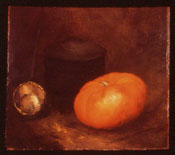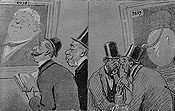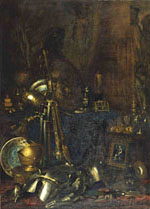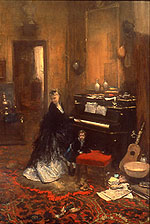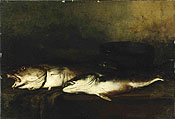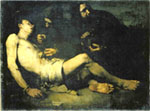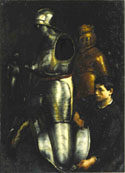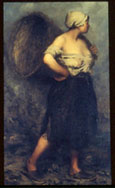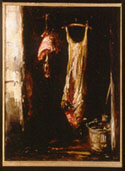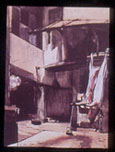The browser will either open the file, download it, or display a dialog.
|
|
Antoine Vollon and His Smashing Pumpkin: On Media Hype and the Meanings of Still Life |
|||||
|
In 1880, at the peak of his career, Antoine Vollon (1833–1900), the renowned painter of still life, exhibited at the Salon a painting that featured a large pumpkin (fig. 1).1 Entitled simply Courge, it generated a wealth of notices in the press that amounted to the most widely favorable criticism ever written about a still life by Vollon. The euphoric language of this criticism validated the artist's career-long efforts to build a reputation of excellence in a genre traditionally perceived as the least important in the hierarchy of acceptable Salon subject matter. Media coverage had played an essential role in the shaping of the public's perception of Vollon as a leader, and an innovator, within the still-life revival movement that began in the 1860s.2 Vollon depended on this publicity to achieve public acclaim and commercial success, and signs of his responsiveness to it can be detected in the way he developed a repertory of visual strategies that he applied to his Salon imagery. A retrospective examination of Vollon's Salon paintings and their criticism, starting with Courge, reveals an ongoing and often conflicted interplay between Vollon and his public, and it fleshes out the meanings embedded in the paintings by which he dually promoted the worthiness of still life as subject matter and his own expertise as a painter of it. | |||||
| Vollon's chief venue for publicity was the Salon exhibition, for which, by 1880, he had sat as a member of the jury for ten consecutive years.3 The ease with which Vollon rose to fame in the 1860s and 1870s belies the extent of the difficulties that confronted him along the way. The jury's traditional standards of acceptance, based on grand-manner figure painting and studiously crafted methods, were often out of step with the growing pool of buyers who were energizing the commodification of collectible art. Put another way, the jury's mandate of upholding time-honored aesthetic criteria was becoming less relevant as the Salon increasingly functioned as a marketplace in which a diversified and growing moneyed public competed for the most desirable—hence most consumable—fine art.4 The very meaning of the concept of artistic excellence, traditionally monitored by designated regulators on the Salon jury, was being mitigated and diluted by the reciprocal interests of popular taste and commercial profitability. In this market-driven economy, an artist's entrepreneurial empowerment depended on an ability to pander to a consensus of taste. Yet this could be at odds with political empowerment, which depended on an ability to maintain official recognition and the status it conferred. Considering still life's inferior status compared to history painting or the painting of the human figure, Vollon's ambition to succeed politically was potentially jeopardized by his public persona as a painter of still life. In his dual roles as a juror, who set standards of artistic excellence, and an exhibitor, whose purpose was to sell his work, Vollon must have been particularly conflicted by these shifts in the cultural faultlines. Evidence embodied in his imagery reveals how he endeavored to define, and redefine, what it meant to be a Salon luminary—and a still-life painter—in a time of complex socioeconomic change, how he juggled aspects of his visual imagery that had proven to be commercially viable with aspects that were less tested and less commercially familiar. He taught himself, as if by trial and error, how to strategize his image-making for the purpose of maintaining and enhancing a popularity dependent not only upon the varying and often unpredictable cultural forces in operation at the Salon at any given time, but also upon a media endorsement vital to the cultivation of the public's perception of his own exceptionality. | ||||||
| Because of its notoriety in the press, the still life Vollon exhibited in 1880 can be viewed as an optimum test case for demonstrating the mechanisms of his visual strategies. Unquestionably, Courge was engineered to attract attention. By its sheer orange brilliance, the pumpkin dominates over the two objects accompanying it, a brass pan and an iron pot, both of which are relegated to subsidiary positions in the surrounding shadows. Seen in its entirety, uncut, in its raw organic state fresh from the country farm, the pumpkin proclaimed itself exceptional not only in its specific location on the wall of the cosmopolitan Salon but within the context of the genre of still life as a whole. Conspicuous despite its seemingly conventional appearance, the still life demanded not only that it be seen, but that its paradoxical identity as extraordinary, though ordinary, be explained. | ||||||
| Critics rose to the challenge, producing verbal responses that were always complimentary and ranged from the humorous to the hyperbolic. The pumpkin was extolled for being "beautiful," "marvelous," "succulent," "vibrant," "shining," "appetizing," "the finest morsel of painting at the Salon," "dead nature transformed into living nature" under the magic wand of the artist's paintbrush.5 They summoned analogies to Chardin, the eighteenth-century virtuoso of still life to whom Vollon often had been compared.6 As if equality with Chardin were not enough, Émile Zola put Vollon in a class with the recently deceased Realist master Gustave Courbet, saying that Vollon was the first "worker" painter to come along since Courbet.7 | ||||||
|
|
||||||
| The most evocative tribute of all came from the novelist Joris-Karl Huysmans, who described the pumpkin as a firework: "turgid, swollen, apoplectic, smeared with cinnabar and orange, like a ball of fire flaming in the night of the painting, exploding in the middle of the anemic paintings which surround it, crushing everything around it."8 This quality of magnetic visual power was also noted by the American Marianna Griswold Van Rensselaer, who called it "a splendid, a regal, an imperial pumpkin . . . an Indian rajah among pumpkins; a portly potentate whose gorgeous orange sides took the life and light and beauty out of everything within eyeshot and made us feel that the only things in the world really worth painting were pumpkins."9 Such florid literary bravura are proof positive that Vollon had at least mastered the art of playing to the press. The supremacy of the pumpkin, and the reputation of the artist who created it, were sealed in the printed word and its references to metaphors of domination, whether organic or human. An anonymous critic added a final flourish to all these accolades when he wrote that Courge had a place reserved for it in the Louvre.10 | ||||||
|
Unofficially, and perhaps somewhat facetiously, Vollon's fellow artists were circulating the comment that his pumpkin could hold its own despite its proximity to the sensational, and critically controversial, Jeanne d'Arc by Jules Bastien-Lepage (Metropolitan Museum of Art, New York).11 For Vollon, the ability of any still life to compete for attention with a high-profile history painting such as Bastien's would have been particularly rewarding as an indication that his mission of promoting still life was indeed succeeding. He would have been further gratified by Huysmans's added statement that his pumpkin had "the ardor of the portraits of Frans Hals transported to still life," meaning, in effect, that it was not only worthy of comparison with figure painting, but artistically on the same high level with it.12 Even two cartoons in the Salon comique, though humorous in their messages, noted the figural potential of Vollon's pumpkin (fig. 2).13 At left, two visitors to the Salon, one with catalogue in hand, examine the portrait of a round-faced man; the caption under the illustration reads, "There, without doubt, is the pumpkin by Vollon about which so much is being said." At right, a different pair of visitors compare their unhealthy complexions to the robust color of an anthropomorphic pumpkin, masquerading as a portrait head with an upside-down pot for a hat. | |||||
| Embedded in this reductively simple Salon still life, and in the overblown critical rhetoric that pays homage to it, are indications that the press's metaphorical references to humanization, exceptionality, and domination were responding to Vollon's cue. His principal strategy was to elevate still life from its traditional categorization as a lesser—and hence less artistically challenging—art form. Courge provides a tactical example of how Vollon manipulated viewer response in order to generate critical notice. The title itself sets the tone when it pointedly gives the pumpkin top billing. The word courge, deliberately chosen by the artist as the term for pumpkin commonly used in his native city, Lyons, could imply a deeper connotation than that of simple reminiscence.14 By sharing the same origins as Vollon, the pumpkin could assume a more profound identity, as a proud fellow countryman or even as a personification of the artist himself. Certainly its rite of passage from humble to triumphant, played out in the media hype, mirrored the artist's ascendant career track from lowly beginnings to acclaimed master of still life. | ||||||
|
|
||||||
| While paradox is latent in the implications of the title, it also visibly pervades the construction of the imagery, strengthening its impact. Distinction is granted to an ordinary pumpkin by reason of its luminous presence and the retainment of its full integral form. An opposition of the familiar and the unfamiliar resides in the way Courge is both like and unlike Chardin. It is similar in the simplicity and symmetry of the pyramid arrangement, and dissimilar in the stark contrasts of lights and darks and in the tension created by the teetering roundness of the pumpkin, poised between balance and disequilibrium. In this way Courge controverts the impression that it is merely an imitation of Chardin and slyly draws attention to itself as notably different. Out of this notability emerges the media's imaginative perception of the pumpkin as a superstar with anthropomorphic potential, literally upgrading it to rival figure painting. After years of developing, testing, and refining his methods, Vollon had proven that he could achieve the heights of celebrity with the humblest of subject matter. | ||||||
|
Selected earlier Salon paintings by Vollon provide corroborative evidence that demonstrates how he endeavored to enhance the status of still life and of his own reputation as a painter of it by strategizing his imagery. His Curiosités of 1868 (Musée d'Orsay, Paris; fig. 3), exhibited at the Salon during the first decade of his career, marked a milestone in his climb to the top of his profession and signified the culmination of his urgent efforts to tap into the career-building rewards of official Second-Empire patronage.15 It originated as a commission cooked up by the politically powerful Comte de Nieuwerkerke, Napoléon III's Superintendent of Fine Arts with whom Vollon had found favor,16 and this virtually guaranteed both monetary reward and institutional award for Curiosités, which won a second-class medal and was purchased by the State.17 Yet, this privileged status did not exempt it from pedestrian commercial interests. In its capacity as a Salon exhibition piece and as a pre-approved sample of the quality of Vollon's work, its chief purpose was to lure future buyers. The seed of this expectation was planted in the choice title, with its connotation of commodified, if valuable, collectibles, available not only on the market but, more specifically, at the auction house.18 The title Curiosités slyly catered to the acquisitive nature of any financially empowered buyer, affirming that the implication of commercial value was not intended as crass or demeaning, but as a celebration of the pleasure and prestige of collecting. For Vollon, this was not in conflict with his other mission, that of proving that the completed tableau was compelling enough to justify, indeed publicize, the honor bestowed on it by a distinguished patron even before it was painted. One senses a striving to make this still life as valuable in its rarity as the precious antiques it portrayed and as noble and refined in its conception and execution as the prestigious collector (and influential politician) whose personal collection it primarily depicted. Thus monetary worth and social prestige, painted commodity and artistic exceptionality, work hand in hand as mutual enhancers of value. The gloss of aristocracy, with its connotation of wealth and titled pedigree, that exudes from this picture could not have given Vollon better credentials. Furthermore, it vindicated and strengthened him in the utilization of a strategy by means of which he had been advancing himself professionally. | |||||
| The full measure of Vollon's ambition is encoded within the painting's virtuosic visual display and sizable dimensions. The lush reds and greens and the glints of shining gold against the murky shadows of the background resonate with a rich old-master sumptuosity, suggestive of Venetian colorism. The lofty verticality of the interior setting declares that this is no ordinary tabletop still life. Here the arrangement is built from the ground up, moving from low to high as if symbolic of the still life's aspiration of elevating its status. Vollon furthered this process of aggrandizement by transforming his towering assemblage of antiquities into a virtual metaphor for history painting, replete with subliminal referencing of the human figure. An ivory statuette of Hercules, an enamel plaque of Marguerite de France as Minerva, the torso of a cuirass, eerily human because complete with arms and gauntlets and lying prone on the foreground floor, constitute an inventory of figural innuendoes. Presiding over the multiplicity of objects like a stern Roman magistrate is a bronze bust of Dante, whose hypothetical body behind the shield evanesces within the murky spatial environment.19 The oblique reference to a phantom human presence stands in sharp contrast to the descriptive factuality of the still-life objects. This stylistic dichotomization found a verbal parallel in the way contemporary critics tended either to praise the still life for the sincerity of its absolute truth to nature or to condemn it for the insincerity of its romanticized historicism.20 On the whole—and perhaps by necessity, given the nature of the commission—they paid tribute to it with beneficent comments regarding its importance, and, by implication, the importance of the collector to whom most of the objects belonged. | ||||||
|
In Un coin de mon atelier (fig. 4), a painting Vollon exhibited in the Salon of 1870, still life competes with human figures literally rather than by innuendo.21 Plentiful still-life elements, arranged across the top and along the side of a piano, resist placements in subsidiary positions and vie for attention with full-length portraits of Vollon's wife and son. The precision of detail with which the accessorizing objects assert themselves contrasts with the delicate, filmy brushstrokes that conjure soft textures of clothing and pink flesh of faces. The paradox of soft and hard visual effects, of sketch as applied to figures and finish as applied to still life, could be construed as a conscious, and arguably subversive, attempt to invalidate any hierarchical classification of either subject matter. Here still life conforms more to standards of proper Salon finish than figure, as if to justify a competitive relationship to figure, or subliminally to assert itself as equally, if not more, significant. | |||||
| In the final analysis, the aesthetic merits of Un coin de mon atelier were virtually ignored by the critics—perhaps surprisingly, in light of the work's obvious appeal.22 The piece was overshadowed by Vollon's other entry in the Salon of 1870 Poissons de mer (fig. 5), a conventional, non-figural, tabletop still life of fish, which was given greater status by being purchased by the State.23 Rather than the ahierarchical leveling of figure and still life as separate but equal genres in Un coin de mon atelier, in Poissons de mer Vollon achieves a subtle fusion of the two by means of an implied anthropomorphism. The grimacing mouths and staring eyes of these vulnerable fish, emotionalized by tenebrous shadows, suggest that they are not dead but that they endure the agony of dying. Vollon's dramatization of his still life resonates stylistically with a painting of martyrdom reminiscent of the Spanish Baroque by Théodule Ribot. Ribot's Saint Sébastien, Martyr (fig. 6), exhibited in the 1865 Salon, represented the saint in death throes rather than deceased.24 As if taking his cue from Ribot, Vollon heightened the sense of fatalistic cruelty by filling the foreground with the shining bodies of his fish. He further refined his characterization by portraying them in different stages of mortality. Because the struggle for life of fish dying out of water was sufficiently commonplace, the critics remained unaware of any manipulative strategy. Poissons de mer was praised for its heightened sense of naturalism; for its "faithful and intelligent reproduction of nature," which allowed the viewer virtually to "smell the odor of the sea."25 Yet in the end it was because of its latent romanticism, its dramatic, humanized enhancement of an otherwise banal realist subject matter, that Poissons de mer was so universally recognized as one of Vollon's best pictures and one that typified his talent.26 The painting of the studio interior exhibited with it was less appreciated because its hybrid mode of expression was less intelligible to, and hence less worthy of notice by, a public that perceived Vollon as primarily a painter of still life. | ||||||
|
The contemporary critical disregard of Un coin de mon atelier may have prompted variations in strategy for the Salon of 1875. One of the two Vollon paintings exhibited, Les armures (fig. 7), invents a new way to mediate with the disjunction between still life and figure in the earlier work.27 A museum exhibit of suits of armor towers above a half-length attendant, who is arranging a piece for display. Like mighty medieval warriors, the shining armor stands straight and tall, proclaiming its dominion over a young man who is truncated at the hips and forcibly squeezed into the lower right quadrant. The relationship between dominant humanoids of steel and subservient figure of flesh and blood betokens uneasy associations on both visual and philosophical levels. Paradox lurks provocatively in the subtext of the imagery. The close juxtaposition of animate and inanimate human forms within a shallow, tenuous spatial environment tends to blur their distinctly separate identities as still life and figure. Mutated into upright stand-ins for man himself, armorial still life has literally transcended to the higher realm of figural art. The coyness of Vollon's strategy eluded many of the critics, who characteristically championed the still-life elements and accused the flesh-and-blood human presence of detracting from the brilliant metallic effect of the armor.28 Yet without that real human presence, and the shrewdly crafted paradox it creates, the image would lose its power to fascinate and, one might add, to fulfill its dual mission not only as a covert promotion of still life but as a demonstration of the painter's ability with the figure, be it in the shape of armor or human flesh. Here Vollon has made visible an iconography of mutual exchange in order to prove himself equally adept at both still life and figure. Even though the provocative, and perhaps unintentionally proto-surreal, iconography must have stood out by the very nature of its stylistic eccentricity, the full extent of its message remained unnoted by contemporary Salon reviewers. In spite of its mixed reception, and probably because of Vollon's firmly entrenched reputation, Les armures was honored by being purchased by the State.29 | |||||
| Perhaps the critics' inability to grasp the finer points of Les armures prompted Vollon to change his strategy once again. His Femme du Pollet (fig. 8), exhibited in the very next Salon, regained any lost ground when it was unanimously lionized by the critics, who viewed this full-length fisherwoman from a suburb of Dieppe as consummate proof of Vollon's ability to paint the figure.30 The large basket on her back, a signature Vollon still life, is solidly fused with the figure, condensing both into a single unbroken silhouette. One senses that here the genres of still life and figure coexist in a state of mutual accommodation, any hint of paradox or competition gone. The visual effectiveness of this painting was substantiated by a public that waxed ecstatic over it. Yet the irony of Vollon's conflicted position as an aspiring figure painter who clung to the need to fortify his public persona as a still-life painter was essentialized into a few terse words by Édouard Manet who described the Femme du pollet as "a basket that walked."31 At a single blow, Manet's rapier wit exposed the still-life/figure paradox and Vollon was banished once again to an unshakable identity as a painter of still life. | ||||||
| Paired with Les armures in the Salon of 1875 was the most potentially quirky still life of Vollon's career. The title Le cochon (fig. 9) identified the animal depicted but gave no hint of the brutality of the depiction, a butchered carcass hanging by its legs from a meathook next to its eviscerated heart and lungs.32 Reviews in the press were lukewarm. Several critics complained that Vollon's freedom of execution, which he had cultivated over the years as his signature style, was in this instance too extreme, as though the painter had dashed it off in a hurry.33 The Realist critic Jules Castagnary preferred the genre painting of the same title by François Bonvin (fig. 10) because it more fully described the interior space and the human activity within it, providing an explanatory context lacking in the Vollon.34 Castagnary's advocacy of a viewpoint that amounted to a solid endorsement of the figural tradition is curiously conservative, as is Bonvin's picture, which adhered to a typically Dutch prototype to tell its story. Vollon, on the other hand, was more innovative in his treatment, daring to fuse style and content within the expressive painterly surface that was becoming his personal trademark. | ||||||
| For our purposes, Vollon's compositional choice of eliminating the wider environment in Le cochon serves not only as a calculated promotion of still life, but as a testament to his own exceptionality within that category of subject matter. The foregrounding of the pig's monolithic wholeness, together with the sly iconographical reference to Rembrandt's slaughtered ox, transforms this humble pig into a single protagonist worthy of association with other Salon figures, rendering irrelevant its banal destiny as edible nourishment.35 Yet, despite this aggrandizing focus on the single figure, Vollon's gutsy painterliness of touch, criticized for not conforming to the paradigm of proper Salon finish, intensifies the sense of vivid corporeality. By bodying forth the illusion that the raw flesh still oozes blood, it leaves an inescapable impression of base realism, bordering on vulgarity. Ultimately, Rembrandt's timeless icon is made into something episodic, contemporary, and quintessentially Vollonian. The boldness of Vollon's craft and the risks taken in his image-making had never been more apparent. Whether he was acclaimed as remarkable or condemned as too eccentric, Vollon's reputation as a painter worthy of notice remained intact. | ||||||
| Five years later, in 1880, Vollon's pumpkin would assert itself as a compelling example of a supreme chief protagonist, willed into animated, even anthropomorphic, existence by a unanimously enthusiastic group of critics. It would seem that after years of plotting strategies, Vollon had fine-tuned his message. He had found a way to make the spectacle of a still life entertain grandly, imaginatively, metaphorically, and he had conditioned his audience to view it that way. Discovering the extraordinary in a seemingly ordinary still life by Vollon had become a critic's prerogative, and the artist's ability to impress those critics, to inspire them to hyperbole worthy of figure painting, signified an asset that underpinned his popularity at the peak of his career. | ||||||
|
|
||||||
| In 1880, while Courge was experiencing its triumph at the Salon, a curiously prescient statement from Émile Zola had cited Vollon as one of the artists who would enable Naturalism to enter the Institut. He wrote that all the energy and power in contemporary art was coming from the painters of reality and of modernity and placed Vollon squarely within this vital Naturalist movement, which was making great strides in opposition to the increasingly isolated painters of the "academic tradition" whose works were becoming more and more mediocre.36 | ||||||
| In 1897—a lengthy seventeen years later and near the end of his life—Vollon was elected to the Institut de France.37 Clearly, this was a personal triumph, an acknowledgment of lifelong achievement, and, for our purposes, the penultimate confirmation that Vollon's strategies of promoting himself as a master of still life had paid off. Furthermore, an institution that epitomized the perpetuation of traditional artistic values had rewarded a painter exclusively identified with still life. High ideals had shifted, even if ever so slightly, off their pedestals, and still life need no longer suffer the disgrace of being an art form judged inferior to others. | ||||||
| Upon Vollon's election, the painter Antoine Guillemet, a close friend of Zola and a self-proclaimed pupil of Vollon, defined what he understood to be its significance in a letter of congratulation whose language essentially confirms Zola's prediction of 1880. He praised Vollon because he did not conform to the prototypical style practiced by members of the Institut, because he was artistically more daring and would therefore bring about a change for the better within this august institution.38 Perhaps Guillemet's portrayal of Vollon as a champion of freedom of expression conveyed a message more historically significant than any of the words voiced by the critics. Through the years Vollon had chipped away at the expectations of those who desired to preserve the status quo, had negotiated with the hierarchical issues of figure painting and still life, and had walked the tightrope between innovation and tradition. His strategized images had often served as polite but nonetheless persistent challenges to the stagnant special interests of the conservative faction with which, as a Salon luminary, he was aligned. He had staked his reputation on the promotion of still life and on the cultural readiness that not only could accept it and market it, but also could ultimately reward it. However late in coming and however moderated by caution, Vollon's election victory, and the further victory of Naturalism that it signified, must indeed have been sweet. | ||||||
|
|
||||||
|
*This article is an expansion of a paper of the same title delivered at the College Art Association Annual Meeting, Toronto, 27 February 1998. 1. Courge was published as no. 3859 in the catalogue of the 1880 Salon where it was mistakenly given a plural spelling. It was purchased during the exhibition or soon after by the New York dealer William Schaus and has been in private collections in the United States ever since. 2. As early as 1868 the critic Ernest Chesneau, inspector of fine arts during the Second Empire, singled out Vollon as a member of the "Young School" (Jeune École), a group he labeled as painters and eccentrics that included Courbet, Degas, Manet, Fantin-Latour, and Boudin. Chesneau called Vollon the artist who most exemplified the peintre exclusif: "everything that appears before his eyes is a pretext for painting" (tout ce qui tombe sous son regard est prétexte à peindre; Chesneau 1869, p. 329). In other words, a painter/executant, enthralled with his medium without concern for thematic content. By 1873, Jules Castagnary made the following comment about the state of the art of still life painting: "still life is one of the triumphs of the modern French school" (la nature morte est un des triomphes de la moderne école française) and he called Vollon "a master of still life" (un maître de la nature morte; Castagnary 1892, vol. 2, 1872–1879, p. 57). Three years later, Joris-Karl Huysmans (1880, unpag.) acknowledged the high level of technical ability exemplified by still-life painters who were satisfying the superficial taste of the general public, but lamented that the majority of them were "artisans who imitate Vollon, assimilating to the best of their ability his terrific (inimitable) technique, forgetting that in addition to his skill, he possesses a temperament, a personality that makes him one of the true 'painters' of our era" (artisans qui imitent Vollon, s'assimilant de leur mieux sa terrible pratique, oubliant qu'en sus de son habileté, celui-là possède un tempérament, une personnalité qui en fait l'un des vrais peintres de notre époque). 3. Although he arrived in Paris in 1859, it was not until 1864 that Vollon finally won acceptance into the Salon exhibition. (His rejection in 1863 prompted his participation in the infamous Salon des Refusés.) Once Vollon began exhibiting at the Salon, he quickly gained recognition from the critics and the public at large, and, most importantly, from Second-Empire officialdom. He had learned how to play the political game that would earn him State patronage and enable him to win numerous awards during the 1860s (third-class, 1865; second-class, 1868; first-class, 1869; Chevalier, Legion of Honor, 1870). 4. Serving as a basis and stimulant for the present investigation are three studies of the social, political, and economic forces interwoven within the framework of the Salon during the period of Vollon's rise to fame: Jane Mayo Roos's Early Impressionism and the French State (1996), Jeannene Marie Przyblyski's "Le parti pris des choses: French Still Life and Modern Painting" (1995), and Patricia Mainardi's The End of the Salon: Art and the State in the Early Third Republic (1993). First published in 1965 but still useful for our purposes is Harrison and Cynthia White's Canvases and Careers: Institutional Change in the French Painting World (1993). The late Nicholas Green, through his article "Dealing in Temperaments: Economic Transformations of the Artistic Field in France during the Second Half of the Nineteenth Century" (1987), influenced the thinking behind this investigation in the way he contextualized works of art as by-products of diverse intersecting cultural and artistic forces. 5. These samples of criticism have been culled from the following sources: Roger-Ballu 1880, p. 40; Anon., July 1880, p. 28; Genevay 1880, p. 350; de Chennevières 1880, p. 59; Anon., May 1880, n. p.; Véron 1875–81, vol. 6, p. 85. 6. Throughout Vollon's career, even in his obituaries, he was compared to Chardin. These comparisons were particularly numerous during the 1860s, when the Chardin revival was strong. As early as 1864, the year of Vollon's very first showing at the Salon, Thoré [Bürger] (1870, vol. 2, p. 106) noted that Chardin was "the master and initiator of this pleiad of young vigorous painters, M. Bonvin, M. Ribot, and M. Vollon" (le maître et l'initiateur de cette pléiade de jeunes peintres vigoureux . . .). Referring to the cauldron depicted in Vollon's Intérieur de cuisine in the 1865 Salon, Théophile Gautier (1865, p. 886) wrote, "Chardin has painted nothing more frank, more accurate, more real" (Chardin n'a rien peint de plus franc, de plus juste, de plus réel). And in 1878, on the occasion of the Exposition Universelle, Émile Bergerat (1878, vol. 2, p. 11) called Vollon "an impassioned Chardin, intoxicated with truth, light, and color" (un Chardin emporté, ivre de vérité, de lumière et de couleur). For thorough investigations into the Chardin revival, see McCoubrey 1964 and Weisberg 1979. An unpublished paper entitled "The Old-Master Component in the Art of Antoine Vollon" was presented by this author at the College Art Association Annual Meeting in Boston, 13 February 1987, which specifically discussed Vollon's debt to Chardin, as well as to Dutch and Spanish Old Masters. 7. Zola, 18 June 1880, as cited in Hemmings and Niess 1959, p. 251. On this occasion, in reference to Courge, Zola wrote, "As for M. Vollon, he is a virtuoso of the palette, he is one of our most adroit painters, and I use the word here in a good sense; there is in him a marvelous worker, with a rich and powerful craftsmanship, such as has certainly not been produced since Courbet." (Quant à M. Vollon, c'est un virtuose de la palette, c'est un de nos peintres les plus adroits, et j'emploie ici ce mot dans un bon sens; il y a en lui un ouvrier merveilleux, d'un métier gras et puissant, tel qu'il ne s'en est certainement pas produit depuis Courbet.) 8. "Turgide, gonflé, apoplectique, barbouillé de cinabre et d'orange, pareil à une boule de feu, ce potiron flambe dans la nuit du tableau, détonne au milieu des grêles peintures qui l'environnent, écrase tout ce qui l'entoure." Huysmans 1880, unpag. 9. Marianna Griswold Van Rensselaer published her commentary years later on the occasion of her visit to the exhibition of the pictures belonging to William Schaus that were sold at auction at the Fifth Avenue Art Galleries on 8 March 1892; Van Rensselaer in Boston Evening Transcript, 12 March 1892, p. 13. This reference was kindly given to me by Lois Dinnerstein and can be found in her unpublished doctoral thesis, "Opulence and Ocular Delight, Splendor and Squalor: Critical Writings in Art and Architecture by Marianna Griswold Van Rensselaer" (1979, p. 111). 10. Anon., July 1880, p. 28. Although Courge was not among them, of the seven Salon paintings by Vollon purchased by the State, two ended up in the Musée du Louvre after first being exhibited at the Musée du Luxembourg. 11. At the 1880 Salon, the Jeanne d'Arc by Bastien-Lepage (1848–1884) was both castigated and praised by the critics; see Aubrun 1985, pp. 172–76, for a bibliographic listing of this criticism. There are two somewhat discrepant accounts that pertain to the installation of Vollon's Courge in the vicinity of Bastien's Jeanne d'Arc at the Salon . According to the American painter/critic Kenyon Cox (1883, p. 558), it was Bastien's painting that was moved around and ended up beside Vollon's pumpkin. Cox, who was an ardent admirer of Vollon, said, "The story is, that when Bastien's wonderful 'Joan of Arc' was exhibited at the Salon, it was taken from one room to another, everyone objecting to have it placed near his picture. Finally it was hung beside Vollon's. Everyone knows the merits of Bastien's picture; the strange sweetness of the face of his Joan, the marvelous completeness of realization of his landscape. Vollon had painted a pumpkin. Yet such was the breadth, the dignity, the nobleness of that pumpkin, that it was Bastien's picture that suffered by the neighborhood, not Vollon's." Forty years later, the story was given a slightly different twist by Vollon's friend, pupil, and biographer Étienne Martin (1923, p. 36), who described how the position of Vollon's pumpkin was changed several times before it came to rest facing Bastien's Joan. He wrote:
Dominique Lobstein at the Musée d'Orsay has indicated that to his knowledge there is no photographic documentation that can verify the exact placement of these two paintings on the wall of the Salon. 12. Huysmans 1880, unpag. 13. Nidrac 1880, p. 20. 14. Vollon's selection of the appropriate title for his pumpkin still life is discussed in a footnote in Martin 1923, p. 36. According to Martin, Vollon spent a month working on Courge. He quotes Vollon as saying about this still life: "I applied the raw material of the painting in a single day . . . ; now I dream of adding something indefinable, something imponderable that constitutes Art." (J'ai mis la matière brute du tableau en un seul jour . . . ; maintenant je rêve d'y mettre cette chose indéfinissable, cette chose impondérable qui constitue l'Art.) 15. Curiosités was published as no. 2531 in the catalogue of the 1868 Salon. Vollon had actively sought State patronage as early as 1860, when he wrote a letter requesting a commission that was endorsed by his close friend Charles-François Daubigny (1817–1878), and fellow lyonnais artists Joseph Soumy (1831–1863) and Hippolyte Flandrin (1809–1864) (Archives Nationales F21/189). 16. Curiosités was composed largely of collectible objects personally owned by the Comte de Nieuwerkerke, who had loaned them to Vollon for the purpose of including them in a still-life painting. Nieuwerkerke's identity as the owner of the collection depicted in Vollon's painting was known, but not widely noted. The Comte's collecting practices and his influence over the art world were recently discussed in an exhibition catalogue entitled Le Comte de Nieuwerkerke: Art et pouvoir sous Napoléon III (Goldschmidt et al. 2000), in which Curiosités is catalogued as no. 86, pp. 140–41. Two earlier articles discuss Nieuwerkerke's direct involvement with the commission of Vollon's Curiosités: Savill 1980 and Tabler 1982. 17. The official commission is dated 2 January 1868 (Archives Nationales, Paris, F21/189), well before the painting's exhibition at the Salon in May of that year. Nieuwerkerke was not only aware of the commission but evidently engineered it, and used his influence to promote himself and his status as a prestigious collector as well as Vollon. 18. During the latter half of the nineteenth century, the term curiosité, signifying a rare and valuable object, carried with it the connotation that its value was determined as much by its purchasing power as by the quality of its workmanship. The perception was growing that collecting was a legitimate commercial enterprise, and publications that reported sale results and other market information were increasingly using the term in their titles, such as La chronique des arts et de la curiosité (begun in 1859), the Revue internationale de l'art et de la curiosité (1869–71), and particularly Paul Eudel's L'Hôtel Drouot et la curiosité (9 vols., Paris, 1885–91). John House discusses the meanings of the word curiosité in Impressions of French Modernity (1998). His brief but cogent comments about Vollon's Curiosités are directly related to the investigations of this article: "Still-life painting itself was viewed as the lowliest of genres in the hierarchy of subject-matter at the Salon; yet Vollon's painting, enormous by the standards of contemporary still life, upgraded the 'curiosités' that formed his subject to the status—or at least to the scale—of true history painting" (House 1998, p. 38, ill. p. 39). The earliest reference to Vollon's transformation of still life into history painting can be found in an obscure source, an introductory essay to a sale catalogue by Wesley Reid Davis, where he states that Vollon "has founded a school of painting in which still life is raised to the dignity of history"; see Stewart sale 1898. 19. An inventory of represented objects, indexed by numbers that are referenced to a photograph of the painting, can be found in the Compiègne exhibition catalogue Goldschmidt et al. 2000, pp. 140–41. 20. The most explicit examples of these two opinions came from Théophile Gautier and Jules Castagnary. Gautier wrote (1868, p. 636) that "everything beautiful that can be contained in the collection of a rich and intelligent art patron is assembled, shines, glistens, is reflected in an illusionistic manner under the paintbrush of this skillful artist who has utilized realism in the right way: absolute sincerity and fidelity to nature" (tout ce qui peut renfermer de beau le cabinet d'un riche et intelligent amateur se groupe, brille, reluit, se reflète de manière à faire illusion, sous le pinceau de l'habile artiste qui a pris le réalisme du bon côté: sincérité et fidélité absolue à la nature). On the other hand, Castagnary (1892, vol. 1, pp. 300–301) expressed his dislike of the painting, pointing out that it tried to include too many objects, was too large in dimensions for a still life, and was too careless in composition. He attributed the fact that it had won a medal to political favor in high places: "Ah! archaism! Ah! the Middle Ages! Ah! the taste for the bibelot so deplorably propagated by romanticism, will there ever be a reason for it?" (Ah! l'archaîsme! Ah! le moyen âge! Ah! le gout du bibelot si déplorablement propagé par le romantisme, n'en aurons-nous jamais raison?). 21. Un coin de mon atelier was published as no. 2920 in the catalogue of the 1870 Salon. It was recently sold at Sotheby's, New York, 3 November 1999, no. 110, and is now in a private collection. 22. Castagnary, the critic who paid the most attention to the painting, disliked Coin for its "dissonance d'idées" and asked Vollon for "a little taste in the conception and a little order in the composition" (un peu de goût dans l'esprit et un peu d'ordre dans la composition); Castagnary 1892, vol. 1, p. 414. 23. Poissons de mer was published as no. 2921 in the catalogue of the 1870 Salon. It was bought by the State on 26 April 1870 (Archives Nationales, Paris, F21/189). It resided first in the Musée du Luxembourg, then in the Musée du Louvre, and is now in the Musée d'Orsay. 24. For a discussion of the State purchase of Ribot's painting, see Weisberg 1981, pp. 600–601. Théodule Ribot (1823–1891), together with François Bonvin (1817–1887), had had an early influence on Vollon after the latter arrived in Paris in 1859 (Martin 1923, p. 16). Ribot and Bonvin specialized in the type of Realist genre painting that was popular with the public but stood somewhat in opposition to academic tradition. Both artists borrowed iconography and styles from the old masters. While Ribot favored the tenebrous tones and religious subject matter of seventeenth-century Spanish painters, Bonvin gravitated towards the rustic interior scenes of Dutch genre and, like Vollon, towards the manner of Chardin in the painting of still life. 25. Ménard 1870, p. 61 and Lemonnier 1870, p. 219. A caricature by Albert d'Arnoux (pseud. Bertall) depicted the fish as still alive and not being able to resist going for a swim in a neighboring marine painting; Bertall 1870, p. 2. Kenyon Cox (1883, p. 560) later remarked that Vollon had captured the essence of the fish: "They are the fish themselves, or, rather, abstract conceptions of fish nature." 26. Poissons de mer is the only work by Vollon in the collection of the Musée d'Orsay chosen for exhibition; the others are usually kept in storage. On the occasion of the Exposition Universelle of 1878, Émile Zola noted that Poissons de mer and Curiosités were Vollon's two best still lifes (July 1878, quoted in Hemmings and Niess 1959, p. 212). The importance of Poissons de mer was recognized even at the moment of its completion. In a letter to Vollon's son Alexis, postmarked 22 September 1904, on the occasion of the death of Mme. Vollon, Henri Cain (1859–1930/37) reminisced about an incident he had observed as a youngster while his father, the sculptor Auguste Nicolas Cain (1822–1894), was visiting Vollon's studio in Le Tréport on the day Poissons de mer was completed. He wrote: "I remember your mother holding the canvas on top of a chair so that it would be in its best light, and my papa saying to yours: 'it's a masterpiece, it's a masterpiece.' I see again your dear mother's eyes following the gestures of my poor (father), now deceased. She was moved, it was the beginning of glory for your admirable father." (Je me souviens de ta maman tenant la toile sur une chaise afin qu'elle fut dans "son jour," et papa disant au tien: "c'est un chef d'oeuvre, c'est un chef d'oeuvre." Je revois les yeux de ta chère maman suivant les gestes de mon pauvre disparu. Elle était émue, c'était la gloire qui commençait pour ton admirable père); excerpt from a letter in a private manuscript collection. 27. Les armures was published as no. 1975 in the catalogue of the 1875 Salon. 28. Castagnary (1892, vol. 2, p. 165) called the figure a mere accessory, "a bit much" (quelque chose de trop), and condemned the artist further with a disdainful comment about the content of his still lifes when he wrote "Bric-a-brac is God and Vollon is its prophet" (Le bric-à-brac est Dieu et Vollon est son prophète). The most scathing attack on Les armures described it as a "soft and soapy" retrogressive work and insinuated that it pandered to a conservative taste because of Vollon's membership on the Salon jury; Véron 1875–81, vol. 1, p. 82. Yet Les armures also provided an opportunity to evaluate the growth in Vollon's reputation. Émile Bergerat (1875, p. 3350) summed up Vollon's identity as a creator of masterpieces when he wrote:
29. The record of the State's purchase of Les armures is in the Archives Nationales, Paris (F21/260). It was first placed in the Musée du Luxembourg, then in the Musée du Louvre, and finally in the Musée d'Orsay. 30. Femme du Pollet à Dieppe (Seine-Inferieure) was published as no. 2043 in the catalogue of the 1876 Salon. This work was universally recognized as Vollon's most sensational figure painting, and much of the commentary about it made flattering analogies with historical precedents. She was called a "plebeian Venus" (Proth 1876, p. 53), an "antique Diana" (Castagnary 1892, vol. 2, p. 218), a "sibyl of Michelangelo" (Cox 1883, p. 557), and one of "those daughters of Antwerp who posed for the goddesses of Rubens" (Bergerat 1878, vol. 1, p. 14). Poems were written about her (Mérat 1876, p. 22, and Dézamy 1876, pl. 40). 31. Claretie 1882–84, vol. 2, p. 210. According to Claretie, Manet said, "Bah! What is Vollon's Femme? A basket that walks" (Bah! . . . qu'est-ce que la Femme de Vollon? un panier qui marche). While there is no documentation to support that Vollon and Manet were ever acquainted, there is evidence that they crossed paths on more than one occasion. Both had exhibited in the Salon des Refusés of 1863, and, perhaps more mystifying, both were depicted in a painting entitled Le toast by Henri Fantin-Latour, which was exhibited in the Salon of 1865 (Bénédite 1905). This painting was later cut up by Fantin himself and only the portraits of Fantin, Whistler, and Vollon survive (Druick and Hoog 1983, pp. 181–92). The surviving portrait of Vollon is in the Musée d'Orsay, Paris. Stylistic correspondences are also evident in the work of Manet and Vollon. Most pertinent here is Manet's practice of including within his portraits and figure paintings assertive still-life compositions. Manet, like Vollon, also flirted with familiar iconographical references, particularly in the 1860s, whether for the purpose of paying tribute to the old masters, rivaling them, or modernizing them. 32. Le cochon was published as no. 1974 in the catalogue of the 1875 Salon. 33. The terms pastiche (Véron 1875–81, vol. 1, p. 82), pochade (quick sketch; Leroi 1875, p. 242; de Lagenevais 1875, p. 929; de La Flécherye 1875, p. 116), and esquisse terminée (finished sketch; de Montaiglon 1875, p. 32) were used in a derogatory sense to describe the loose brushwork of Le cochon, as if such a quickly painted sketch did not belong on the wall of the Salon. While Mario Proth (1876, pp. 48–49) praised it as masterful enough to have been signed by Rembrandt, noting the iconographical reference, he qualified his remark with a request that in future Vollon paint fewer "tidbits" (morceaux) and add more "content" (sujet) to his compositions. 34. Castagnary 1892, vol. 2, p. 163. Castagnary said of Bonvin's Cochon:
Bonvin's Le cochon (Musée Saint Denis, Reims) is discussed and catalogued by Gabriel P. Weisberg in Bonvin (1979, no. 59, ill. p. 113); Vollon's version is reproduced as well (p. 112). Curiously, the ideas for both Bonvin's and Vollon's slaughtered pigs may have derived from, or at least are related to, a work by Amédée Élie Servin (1829–1885/6) entitled Puits de charcutier and exhibited in the earlier Salon of 1869 (Gazette des Beaux-Arts 1 [1869], p. 510, ill.). Since permission to reproduce Bonvin's actual Salon painting of 1875 has not been forthcoming, a reproduction of a study of this painting has been provided; see fig. 10. 35. The resemblance to Rembrandt was noted by more than one critic because it was so openly and intentionally referenced by Vollon (Montaiglon, Leroi, and Proth, see note 33 above). Jules Claretie was particularly flattering in his commentary: "[T]his magnificent flayed Pig by Vollon . . . could almost hold its own next to The Ox in the Butcher's Stall by Rembrandt. What color! What vigor! How powerful, daring, bloody and true it is!" (ce magnifique Cochon écorché de Vollon . . . pourrait presque figurer à côté du Boeuf à l'étal de Rembrandt. Quelle couleur! Quelle vigueur! Comme cela est puissant, hardi, saignant et vrai!); Claretie 1876, p. 353. 36. Zola, 18 June 1880, in Hemmings and Niess 1959, pp. 253–54.
38. Guillemet (1843–1918) wrote: "Here is the first time that a painter, a true painter, has entered this establishment usually reserved for the classicists, for the Bouguereau's, people who paint properly, inoffensively . . . therefore Bravo for you and especially Bravo for the Institut to which your nomination can only do good" (Voilà la première fois qu'un peintre, un vrai peintre, entre dans cette maison réservée d'habitude aux classiques, aux Bouguereau, gens à peinture propre et peu gênante . . . Bravo donc pour toi et Bravo surtout pour l'Institut à qui ta nomination ne peut faire que du bien); excerpt from a letter in a private manuscript collection. |
||||||


